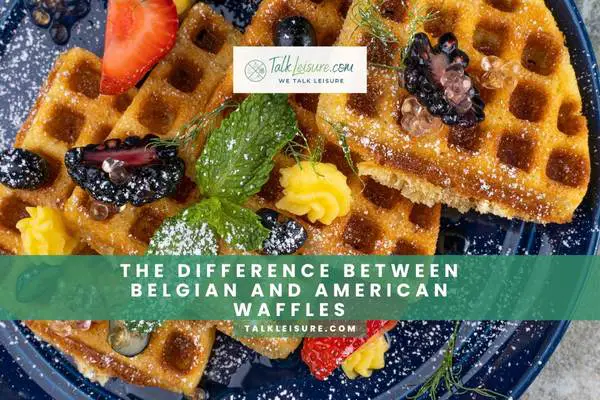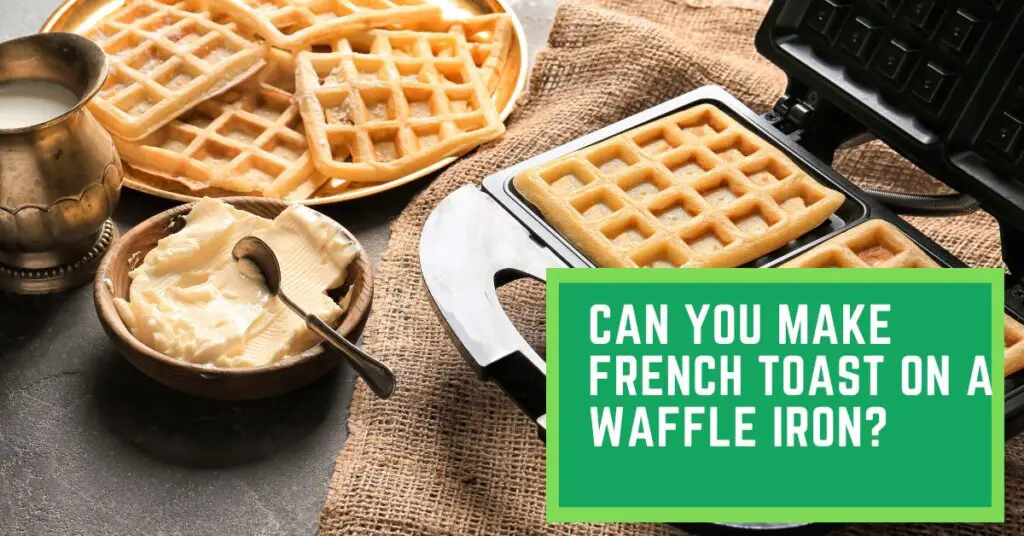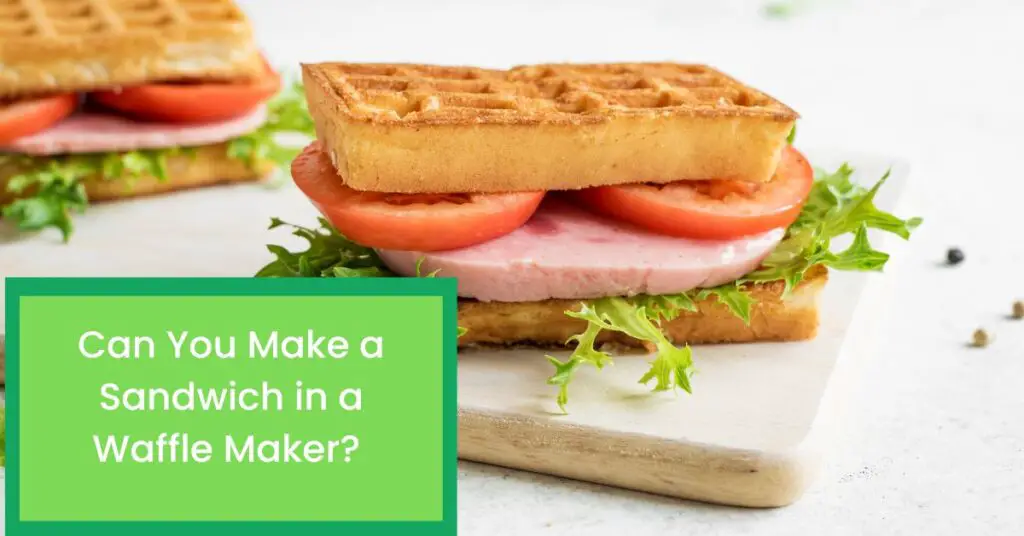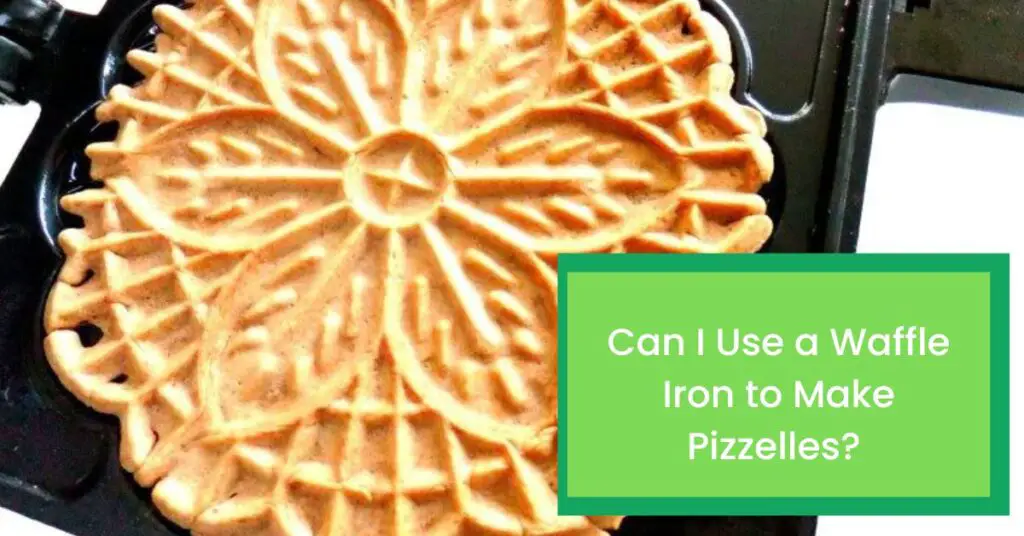Do you ever wonder what makes a Belgian waffle different from other waffles? Well, wonder no more because we are here to tell you all about it!
Belgian waffles are a beloved breakfast food that can be enjoyed as a dessert. They are crispy on the outside and light and fluffy on the inside, making them an irresistible treat for any time of day.
Belgian waffles originated in Belgium (hence their name) in the 18th century.
They were originally called ‘Brussels waffles’ after the city where they were first made, but they became known as Belgian waffles over time.
These delicious treats can be found worldwide and have become a popular staple in many households.
So, let’s dive into what makes a Belgian waffle so special and how you can enjoy it at home!
The Origins Of Belgian Waffles- History Of The Belgian Waffle

The story behind the creation of this delicious treat is steeped in history and tradition, making it more than just a simple breakfast item.
Initially known as ‘gaufres,’ these early waffles were thin and crispy, with a honeycomb-like pattern that made them easy to break apart and share.
Over time, Belgian waffles evolved into the thicker, fluffier treats we know today.
It wasn’t until the 19th century that Belgian waffles began to take on their signature rectangular shape.
This evolution was partly due to technological advancements (such as electric waffle irons) but also reflected changing consumer tastes and preferences.
Today, Belgian waffles remain a beloved breakfast food worldwide – though they are often served as dessert or even enjoyed as a snack!
Belgian waffles are often known as Brussels waffle.
Speaking of breakfast foods, you may wonder: What’s the difference between Belgian and American-style waffles?
While both types are made from batter cooked on a hot iron, there are some key distinctions between them…
The Difference Between Belgian And American Waffles

You’ll notice a distinct difference between how American and Belgian waffles are made.
Belgian waffles are typically lighter, crispier, and have larger squares. American waffles are fluffier, thicker, and smaller, with a slightly sweeter taste.
While both have a similar shape, Belgian waffles are thicker and have deeper pockets, resulting in a fluffier texture.
On the other hand, American waffles are thinner with shallower pockets, resulting in a crispier texture.
The waffle iron used plays a significant role when making these two waffles.
For Belgian waffles, you’ll need a deep-pocketed iron to hold more batter and cook the waffle evenly on both sides.
American waffles require a shallow-pocketed iron that can quickly cook the thin batter to achieve its crispy texture—an authentic Belgian waffle recipe governing the history of the Belgian waffle.
However, if you’re looking for versatility and want to make both types of waffles using one iron, consider getting an adjustable temperature iron that allows you to change the depth of the pockets according to your preference.
As we discuss the ingredients of Belgian waffles, it’s worth noting that choosing the right type of iron is crucial in achieving the perfect texture for your preferred waffle style.
Belgian Waffle Vs Regular Waffle
The difference between Belgian waffles and regular waffles was always a hot topic.
Not only Belgian boys and girls but everyone worldwide is interested in it. The main difference is the waffle batter and powdered sugar used while serving.
You can make it using a regular waffle maker, as many other waffles are often made.
Even though there are different types of waffles, many still prefer traditional waffles.
Also, the type of waffle maker waffle makers affect the texture of the waffle.
Sometimes, the waffle irons that doesn’t make pockets properly will not give you the perfect crispiness.
Difference Between Belgian Waffles And Regular Waffles
The difference between waffles was always debatable. Belgian and regular waffles may share some similarities, such as being made with waffle mix and cooked on a waffle iron, but there are notable differences.
Belgian waffles are typically larger and thicker than standard waffles, thanks to the deeper pockets on the Belgian waffle iron.
On the contrary, regular waffles are smaller and thinner in comparison.
Additionally, Belgian waffles are often made with buttermilk, giving them a slightly tangy flavor, while regular waffles can be made with various ingredients.
So, the size, thickness, and ingredients used make Belgian waffles distinct from regular waffles.
The Ingredients Of Belgian Waffles

To achieve the perfect texture for this classic breakfast dish, it’s essential to understand the ingredients that go into it.
Belgian waffles contain flour, eggs, milk, butter, sugar, yeast, and vanilla extract. Cooked in a waffle iron, they’re crispy outside and fluffy inside, often served with toppings like fruits and syrup.
Belgian waffles are known for their light and crispy texture on the outside, with a fluffy and airy interior.
The secret lies in the batter, which consists of flour, sugar, eggs, milk, butter, yeast or baking powder, and vanilla extract.
Here is a breakdown of each ingredient’s role in creating the perfect Belgian waffle:
| Ingredient | Role |
|---|---|
| Flour | Provides structure |
| Sugar | The leavening agent that creates air pockets for a light texture |
| Eggs | Add richness and bind everything together |
| Milk | Adds moisture for a tender crumb |
| Butter | Provides flavor and aids in browning |
| Yeast/Baking Powder | Leavening agent that creates air pockets for a light texture |
| Vanilla Extract | Adds a subtle aroma and flavor |
There are alternatives to some of these ingredients for those looking to make healthier options for their breakfast meal.
For example, swapping out all-purpose flour with whole wheat flour increases fiber content while still providing structure.
Using honey or maple syrup instead of refined sugar adds natural sweetness without spiking blood sugar levels.
Replacing some or all of the butter with applesauce or mashed bananas can reduce saturated fat content while still giving moisture and flavor.
Egg white and crunchy pearl sugar adds extra taste, as Belgian waffles use yeast and are often made with butter milk.
Belgian waffles have been enjoyed worldwide for many years, but did you know there are variations beyond just toppings?
Let’s dive into some unique takes on this beloved breakfast food.
Best Belgium Waffle Recipe To Make Authentic Belgian Waffle -Variations Of Belgian Waffles

You’re missing out on a world of delicious breakfast possibilities if you haven’t explored the many creative twists on this beloved dish.
Belgian waffles have been adapted countless ways to cater to different tastes and dietary needs.
One popular variation is sweet vs. savory waffles.
While traditional Belgian waffles are usually served with syrup and whipped cream, sweet versions can also be made with fruit toppings, chocolate chips, or caramel drizzles.
On the other hand, savory varieties often include ingredients like cheese, bacon, and herbs.
So, Variations of Belgian waffles include classic, chocolate chip, fruit-topped, whipped cream and syrup, savory with bacon and cheese, and nut-covered.
Another important aspect of modern Belgian waffles is gluten-free options.
Plenty of gluten-free flour can be used as a substitute for wheat flour in waffle recipes for those who suffer from celiac disease or gluten intolerance.
Almond and coconut flour are popular choices that produce crispy yet fluffy waffles without compromising taste or texture.
As you explore the many variations of Belgian waffles, remember that serving suggestions can also make a big difference in how your dish turns out.
Small touches can take your breakfast game to the next level, adding fresh berries for a pop of color or serving with a dollop of yogurt for extra creaminess.
Ways To Eat A Belgian Waffle – Serving Suggestions

To elevate your breakfast experience, try incorporating different topping options and pairing suggestions to make your Belgian waffles more exciting.
Some classic toppings include butter and syrup, whipped cream and fresh fruit, or Nutella and bananas. Try topping your waffle with crispy bacon or scrambled eggs for a savory twist.
Pairing suggestions can also take your waffle game to the next level.
A hot coffee or tea is always a great choice, but why not experiment with other beverages?
A glass of orange juice or a mimosa can add some extra zing to your morning meal.
If you’re feeling indulgent, pair your waffles with crispy hash browns or breakfast sausage for the ultimate brunch experience.
Belgian waffles as a breakfast food are versatile and delicious in their own right, but adding creative toppings and pairings can truly take them to the next level.
Belgian Waffles As A Breakfast Food

Start your morning with a scrumptious and satisfying breakfast by savoring sweet or savory treats from this delectable dish.
Belgian waffles aren’t just perfect for special occasions and make a great breakfast food that can jumpstart your day.
Here are five reasons why you should consider having Belgian waffles for breakfast:
- They’re rich in nutrients like iron, calcium, and vitamin B6, which can help promote healthy bones, muscles, and brain function.
- They provide the necessary energy to kick-start your day since they’re made with flour, eggs, milk, and butter.
- They’re versatile toppings. You can top off your Belgian waffles with fruits like strawberries or blueberries to add some natural sweetness, or go for bacon and eggs to enjoy a hearty meal.
- Making Belgian waffles is easy if you have a good quality waffle maker at home. It saves time in the morning rush without compromising on taste.
- Having Belgian waffles for breakfast is an excellent way to treat yourself while ensuring you get all the necessary nutrients.
Belgian waffles as a dessert are equally delicious.
Drizzled with chocolate syrup or topped off with whipped cream makes it an irresistible dessert option everyone loves!
Belgian Waffles As A Dessert

Satisfy your sweet tooth with a mouthwatering dessert that’s crispy on the outside and fluffy on the inside, topped off with luscious chocolate syrup or creamy whipped cream.
Belgian waffles make for a delectable dessert that can be enjoyed at any time of day.
Add fresh fruits like strawberries, blueberries or bananas to your Belgian waffle and indulge in a healthy yet delicious treat.
To take your Belgian waffle experience up a notch, try experimenting with different toppings such as honey, maple syrup, Nutella, caramel sauce or ice cream.
Pairing it with the right drink can also enhance the flavors of this classic pastry.
For instance, coffee is an excellent choice to complement the sweetness of a Belgian waffle.
Alternatively, you could opt for tea or hot chocolate to balance out the richness of this dessert.
Belgian waffles around the world have their unique twists and turns.
From savory options like chicken and waffles in America to sweet delights like Liege Waffles in Belgium, countless variations exist.
Let’s delve into some of these global interpretations and discover how they differ from traditional Belgian waffles.
Belgian Waffles Around The World

You’ll be amazed at the variety of twists and flavors waffles offer worldwide.
But have you ever tried a waffle with chicken or one covered in syrup made from brown sugar?
Belgian waffles may have originated in Belgium but have become a global phenomenon. Each country has put its twist on this classic breakfast food, giving it a unique flavor.
Belgian waffles can be found worldwide, each with their regional variations.
In America, chicken and waffles are a popular dish where fried chicken is paired with fluffy Belgian waffles drizzled with maple syrup.
In Hong Kong, egg puffs are a famous street snack inspired by Belgian waffles.
The batter is flavored with green tea powder or chocolate and then cooked in special molds to create small egg-shaped puffs.
Other countries like Japan and Korea serve sweet potatoes, or red bean pastes as toppings on their Belgian waffles.
You can even find savory versions of Belgian waffles in Germany, served topped with cheese and ham, making them more like an open-faced sandwich than a traditional breakfast food.
The regional variations of Belgian Waffles are limitless. Whether you prefer your Belgian waffle sweet or savory, there’s no denying that this classic breakfast food has become an international sensation.
People worldwide enjoy their unique take on this delicious treat from America to Asia to Europe.
Enjoying Belgian Waffles At Home – Let’s Make Belgian Waffles

So, you want to enjoy Belgian Waffles at home? Well, the first thing you’ll need is a waffle maker.
Don’t worry; they come in various sizes and price points.
Once you’ve got your equipment, learn some tips for storing and reheating your waffles to be fresh and delicious whenever you crave them.
Equipment Needed For Making Waffles – Best Belgian Waffle Maker
You only need a waffle maker and basic kitchen ingredients to make delicious Belgian waffles.
Here are some equipment essentials to ensure that your waffles come out perfect every time:
Waffle Maker: This is the most important equipment you’ll need. Many types are available, so choose one that suits your needs and budget.
Measuring Cups and Spoons: Accurate measuring is key to making great waffles, so invest in good quality measuring cups and spoons.
Mixing Bowls: You’ll need at least two mixing bowls – one for dry and one for wet ingredients. Use stainless steel or glass bowls as they won’t react with acidic ingredients like lemon juice or buttermilk.
Whisk or Mixer: A whisk or mixer will help ensure the batter mixes well without any lumps.
Once you have all the necessary equipment, it’s time to start making waffles!
Check out our next section for tips on how to get started.
Now that you have everything you need to make delicious Belgian waffles let’s move on to the next step – storing and reheating them.
Tips For Storing And Reheating Waffles
If you want to enjoy your homemade Belgian waffles later, knowing how to store them properly is important.
First, ensure the waffles have completely cooled down before storing them in an airtight container or plastic bag. You can also separate each waffle with parchment paper to prevent them from sticking together.
When it comes to reheating the waffles, there are several options.
The easiest and quickest way is to use a toaster or toaster oven, which will give you crispy edges and a soft center.
Alternatively, you can reheat them in the oven by placing them on a baking sheet at 350°F for about 5-10 minutes until heated.
Another option is to microwave the waffles for about 30 seconds on high power, which may result in soggy waffles if not done correctly.
With these tips, you can enjoy your homemade Belgian waffles even after they’ve been stored for days!
Conclusion
Congratulations, you now know everything there’s to know about Belgian waffles! You’re now a true connoisseur of this delicious treat.
But wait, there’s more! Not only do you know the origins and ingredients of Belgian waffles, but you also have various serving suggestions and variations to try out at home.
So go ahead and indulge in some Belgian waffles for breakfast or dessert. Make them your own by adding your favorite toppings or trying new flavors.
Your taste buds will never get bored with all the different ways you can enjoy these fluffy delights.
And don’t forget to share your creations with friends and family – they won’t want to miss out on the Belgian waffle’s goodness.
Frequently Asked Questions
How Many Calories Are In A Belgian Waffle?
A Belgian waffle can range from 300 to 500 calories per serving, depending on the recipe and toppings.
While it does contain some essential nutrients like carbohydrates, protein, and calcium, it’s also high in sugar and saturated fat. This can lead to weight gain and other health problems if consumed excessively.
What Is The Best Type Of Syrup To Use On Belgian Waffles?
You may find yourself in a syrup dilemma when it comes to topping your Belgian waffles. Maple syrup is the classic choice.
Honey has antioxidants and can help soothe a sore throat.
But let’s not forget about Nutella – that decadent chocolate spread pairs perfectly with the fluffy texture of a Belgian waffle.
Ultimately, the best topping for your Belgian waffle depends on your preferences and dietary needs.
Can Belgian Waffles Be Made Without A Waffle Iron?
Some have successfully used a panini press or a regular frying pan.
Add ingredients like bacon, cheese, or herbs to the batter if you’re looking for savory variations.
For sweet options, top your waffles with fresh fruit, whipped cream, and your favorite syrup.
While these alternatives may not give you the same crispy texture as a waffle iron would, they’re still delicious in their own way and worth trying out if you don’t have access to one.
Is There A Gluten-Free Version Of Belgian Waffles?
The gluten-free versions typically use alternative flours like almond flour or rice flour instead of wheat-based flours, making them suitable for those with celiac disease or gluten intolerance.
While traditional Belgian waffles may not be the healthiest breakfast option due to their high sugar and calorie content, opting for a gluten-free version made with healthier ingredients can provide a more nutritious meal without sacrificing taste.
What Is The History Behind The Name “Belgian Waffle”?
These delicious treats were first introduced in Belgium during the 18th century and quickly became popular across Europe.
However, when they were brought to America for an exposition in 1962, they were mistakenly referred to as ‘Belgian’ waffles due to their country of origin.
Regardless of their name, these delectable treats are beloved worldwide for their crispy exterior and fluffy interior.
Happy eating!





